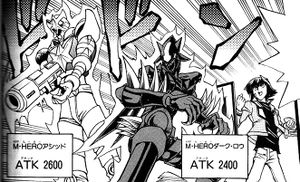Difference between revisions of "Masked HERO"
| Line 16: | Line 16: | ||
* [[Premium Pack 13]] | * [[Premium Pack 13]] | ||
* [[Generation Force]] (TCG only) | * [[Generation Force]] (TCG only) | ||
| − | | list = List of "Masked HERO" | + | | list = List of "Masked HERO" cards |
| support list = List of "Masked HERO" support cards | | support list = List of "Masked HERO" support cards | ||
}} | }} | ||
Revision as of 00:30, 28 September 2011
| Masked HERO | |||
|---|---|---|---|
|
| |||
| Japanese |
| ||
| Japanese (base text) |
M・HERO | ||
| Japanese (romanized) |
Masukudo Hīrō | ||
| Japanese (translated) |
Masked HERO | ||
| |||
| Appears in (sets) |
| ||
| Appears in (manga) | |||
| Lists |
| ||
Masked HEROES (M·Heroes) are a subclass of "HERO" monsters used by Jaden Yuki in the manga.
They are currently the only monsters shown to perform Transformation Summons and Double Attacks.
In yet-to-be-released OCG, rather than Fusion Summoning like most Fusion Monsters do, they use cards like Mask Change to Special Summon themselves from the Extra Deck.
So far, the archetype consists of 5 Normal Monsters and 5 Transformation Monsters. It favors a fairly straight-forward Beatdown strategy, with "Goka" gaining 100 ATK for every HERO in the Graveyard,"Acid" destroying all spells and traps the opponent has and decreasing their monsters ATK and "Vapor" being unable to be destroyed except by battle and "Daian" Special Summoning more HEROES to the field. So far "Dark Law" is the only Transformation monster whose ability is unknown at the moment.
While the "Elemental HEROES" are said to be based off of American superheroes, it can also be assumed "Masked HEROES" are a salute to Japanese Super Sentai or Kamen Rider heroes. Especially since "Kamen" means "Masked" as well as sharing several similarities such the recurring "form changing" and transformations of Kamen Riders. The Double Attacks are also similar to the original Kamen Riders' (1 and 2) "Rider Double" techniques.
